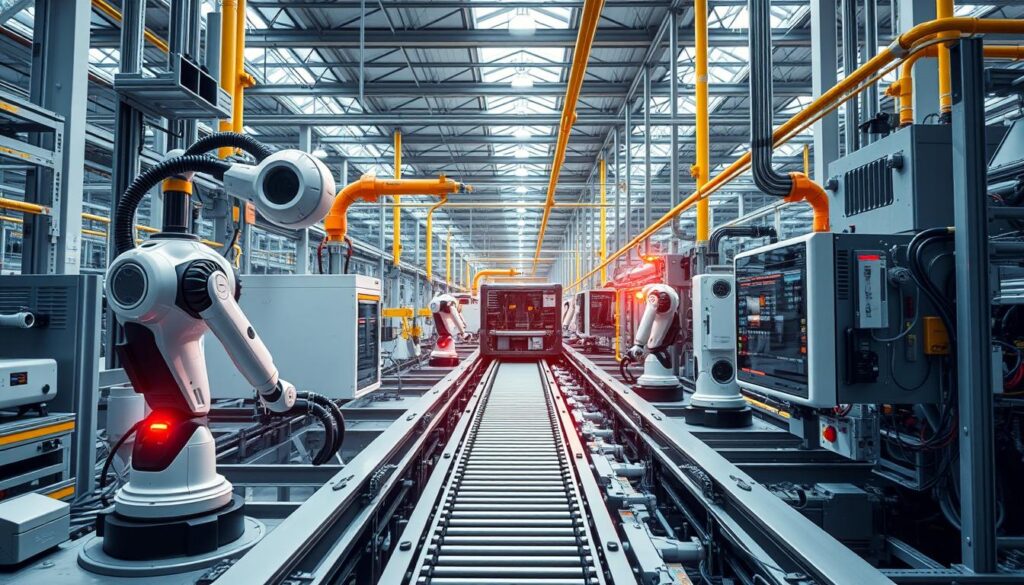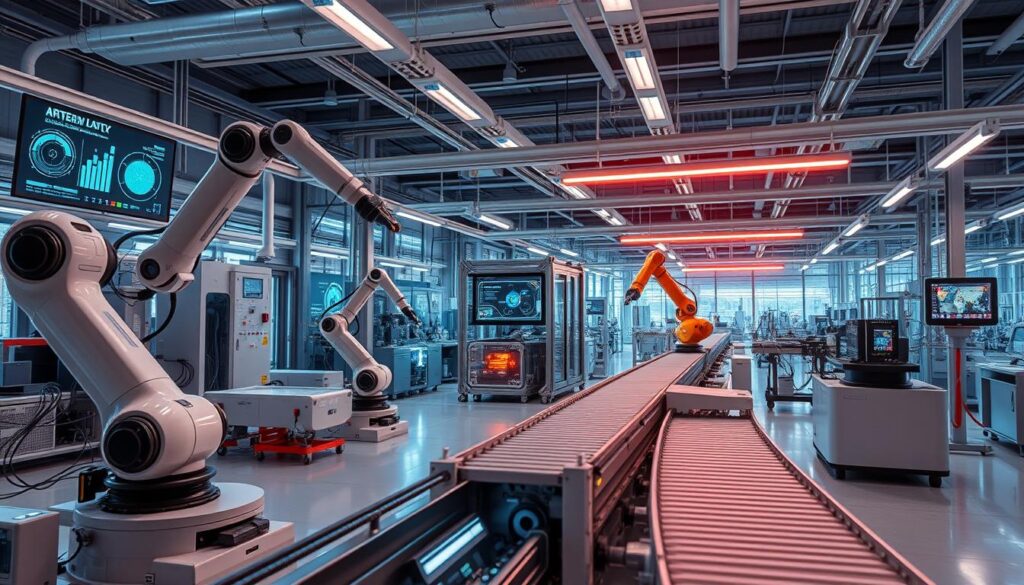The world of modern manufacturing is changing fast. Smart factories are leading this change, starting a new Industrial Revolution 4.0. At the center of this change are smart components. These are new technologies that are changing how we make things, automate, and use Industry 4.0 solutions.
For manufacturers to keep up, it’s key to know about these smart components. They need to understand what they can do and how to get them. This is important for making the most of smart factory operations.
Key Takeaways
- Explore the latest technologies powering smart components for smart factories
- Understand the key features and benefits of integrating smart components into your manufacturing operations
- Discover effective strategies for sourcing high-quality smart components from reliable suppliers
- Learn about the importance of quality control and certification standards in the smart components market
- Gain insights into the compatibility and interoperability considerations when deploying smart components
What are Smart Components for Smart Factories?
Smart components are advanced devices that make manufacturing automated and data-driven. They use new tech like the Internet of Things (IoT), artificial intelligence (AI), and sensors. These tools collect and analyze data in real-time to improve production and operations.
Exploring the Tech Behind Automated Manufacturing
Smart factories rely on smart components. These components use IoT devices, sensors, and connectivity to collect data. AI and analytics then process this data for smart decisions and adjustments.
Key Features of Smart Components
- Connectivity: Smart components have strong connectivity. This lets them share data across the factory.
- Data Analytics: They use advanced sensors and algorithms. This helps them analyze data in real-time for better decision-making.
- Remote Monitoring: You can monitor and control smart components from anywhere. This makes maintenance and troubleshooting easier.
- Predictive Maintenance: They can predict when maintenance is needed. This prevents unexpected downtime and improves asset use.
| Smart Component Feature | Benefit |
|---|---|
| Connectivity | Enables seamless data sharing and integration across the factory ecosystem |
| Data Analytics | Provides real-time insights to optimize production and quality |
| Remote Monitoring | Allows for proactive maintenance and remote troubleshooting |
| Predictive Maintenance | Helps prevent unexpected downtime and optimize asset utilization |

Sourcing Smart Components for Smart Factories
Finding the right smart components for your factory is key to smooth operation and top performance. It’s important to use smart sourcing smart factory components and supplier evaluation. Also, have a solid procurement strategies that fit your supply chain optimization goals.
When searching for suppliers, look for those with a history of quality and compatibility. Check their technical skills, quality checks, and support services.
- Check supplier skills: Look at their products, tech know-how, and customization options.
- Focus on quality and reliability: Make sure they follow strict quality standards and offer certifications.
- Think about long-term support: See if they promise updates, help with problems, and easy integration.
| Criteria | Supplier A | Supplier B | Supplier C |
|---|---|---|---|
| Product Portfolio | Comprehensive range of smart components | Limited selection of smart components | Specialized in select smart components |
| Quality Certifications | ISO 9001, UL, CE | ISO 9001 | UL, CE |
| Technical Support | 24/7 assistance, dedicated account manager | Business hours support, general inquiries | Limited support, no dedicated contact |
Choosing the right sourcing smart factory components suppliers is crucial. It helps you improve your procurement strategies and supply chain optimization. This ensures your smart factory runs smoothly.

Evaluating Smart Component Suppliers
When looking for smart components for your smart factory, it’s key to check suppliers well. You need to make sure they meet your quality, safety, and performance needs. Look at their quality control, certifications, and other important factors to find the best partners.
Quality Control and Certification Standards
Choose suppliers who focus on quality control. They should have strict testing, inspections, and quality management systems. Make sure their products meet or go beyond industry standards like ISO, IEC, or ANSI.
Also, see if the supplier is dedicated to getting better and working with you on quality issues. A supplier who is open and proactive about quality can make you trust their components for your smart factory.
| Evaluation Criteria | Importance |
|---|---|
| Quality Control Measures | High |
| Industry Certifications | High |
| Supplier Responsiveness | Medium |
| Financial Stability | Medium |
By carefully checking smart component suppliers, you can find reliable partners. They will help your smart factory succeed in the long run.
Integrating Smart Components into Your Factory
Adding smart components to your factory is key to smart manufacturing success. It’s vital to think about compatibility and interoperability for a smooth transition. This ensures you get the most out of your new technology.
Compatibility and Interoperability Considerations
When adding smart components, check if they work with your current setup. Look at the hardware and software needs, and the communication protocols. This ensures a smooth fit with your factory’s systems.
- Check if the smart components match your factory’s electrical and mechanical systems for easy integration.
- Make sure the smart components can talk to your control systems for true interoperability.
- Look at the software needs to see if the smart components fit into your system integration framework.
By focusing on these points, you can make the smart component integration process smoother. This way, you can fully enjoy the benefits of factory automation in your facility.
Conclusion
In the era of Industry 4.0, using smart factory components is key. It turns your manufacturing into a data-driven, efficient powerhouse. With the latest IoT, sensors, and analytics, you can boost production, quality, and stay competitive.
This guide has given you the insights and strategies for smart components in your factory. You now know how to automate, evaluate suppliers, and integrate these components. This knowledge will elevate your factory to the next level of smart manufacturing.
Starting your smart factory journey? Remember to source reliable components, ensure they work together, and use data insights. By embracing smart manufacturing, Industry 4.0, and industrial automation, your smart factory components will be the foundation of your success.
